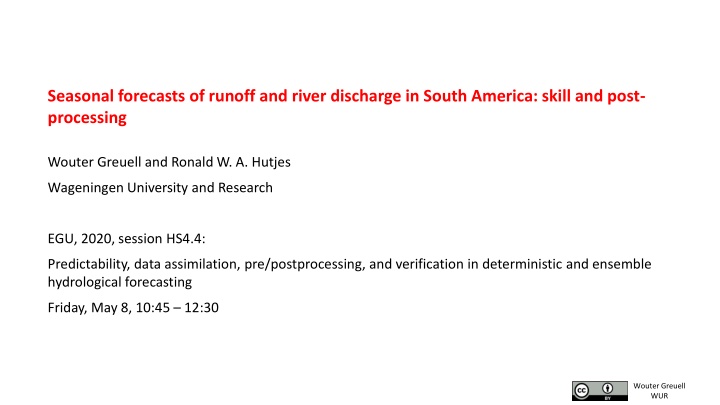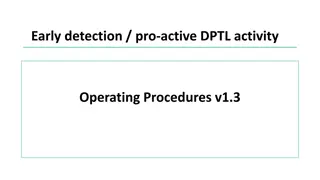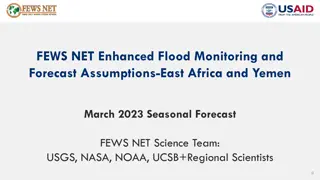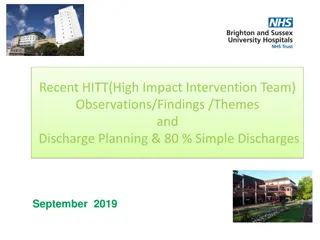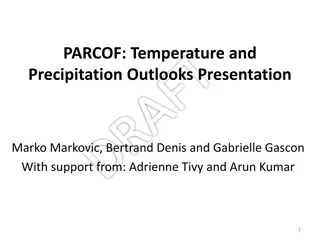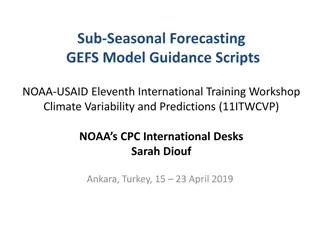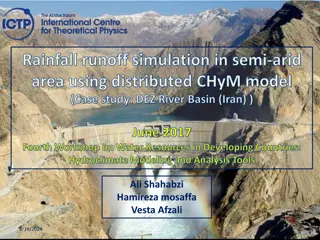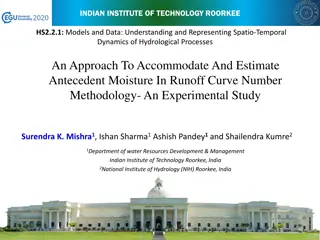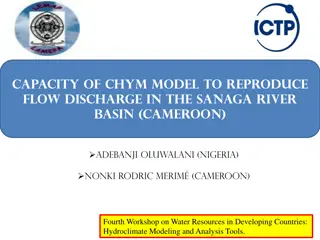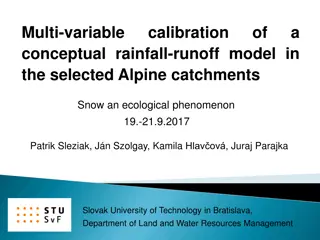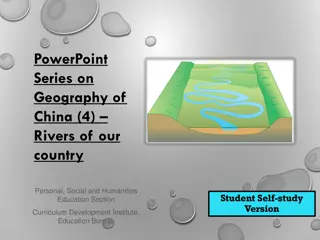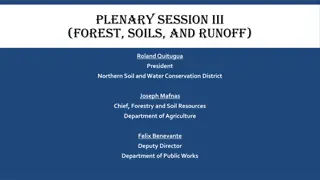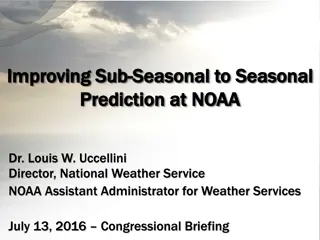Seasonal Forecasts of Runoff and River Discharge in South America
Study on skill and post-processing of seasonal forecasts of runoff and river discharge in South America using hindcasts and reference simulations. Evaluation method and results are discussed for assessing forecast skill.
Download Presentation

Please find below an Image/Link to download the presentation.
The content on the website is provided AS IS for your information and personal use only. It may not be sold, licensed, or shared on other websites without obtaining consent from the author.If you encounter any issues during the download, it is possible that the publisher has removed the file from their server.
You are allowed to download the files provided on this website for personal or commercial use, subject to the condition that they are used lawfully. All files are the property of their respective owners.
The content on the website is provided AS IS for your information and personal use only. It may not be sold, licensed, or shared on other websites without obtaining consent from the author.
E N D
Presentation Transcript
Seasonal forecasts of runoff and river discharge in South America: skill and post- processing Wouter Greuell and Ronald W. A. Hutjes Wageningen University and Research EGU, 2020, session HS4.4: Predictability, data assimilation, pre/postprocessing, and verification in deterministic and ensemble hydrological forecasting Friday, May 8, 10:45 12:30 Wouter Greuell WUR
THE FORECAST SYSTEM: TWO TYPES OF SIMULATIONS (HINDCASTS) Atmosphere and ocean model, SEAS5 (ECMWF) Hydrological model VIC Runoff and river discharge Forcing: precipitation 2 m temperature, wind, humidity and incoming radiation Wouter Greuell WUR
HINDCASTS - Forcing from SEAS5 (ECMWF) hindcasts - Period 1981-2015 - Start each month (so 12 x 35 starting dates) - 25 members (so 12 x 35 x 25 = 10500 runs) - Duration of runs: 7 months - Hydrological model: VIC - Resolution: 0.5 degrees; domain South America - Initial conditions from reference simulation (see next slide) Wouter Greuell WUR
IN ADDITION TO HINDCASTS: REFERENCE SIMULATION Is the best possible simulation of the hydrological system during the period of the hindcasts: hydrological simulation with VIC, forced with meteorological observations (WFDEI with precipitation data from GPCC) Two purposes of this simulation - create initial states for hindcasts (snow, soil moisture, river discharge) - create pseudo-observations of hydrological variables for skill assessment Wouter Greuell WUR
EVALUATION OF FULL HINDCASTS Wouter Greuell WUR Summary of evaluation: fraction of all (12) target and 6 lead months (first in excluded) with significant skill Example of evaluation: target month November with initialization on September 1 (lead time: 2 months) Evaluation Of runoff, i.e. streamflow in local rivers Observations: pseudo-observations, i.e. runoff from reference simulation Metric: correlation coefficient between observation and ensemble mean of the forecasts Significant skill: skill exceeding the 95% confidence level Corr. Coeff. Fraction Threshold of signif. skill
3 SETS OF HINDCASTS GOAL: ISOLATE SOURCES OF (DISCRIMINATION) SKILL Note: this scheme represents all hindcasts with initialization on April 1. Scheme is similar for initialization in other calendar months! Name set Full Init Meteo Includes skill due to ... Forcing and initial conditions Initial conditions only Forcing only Forcing for year i SEAS5 initialized on Apr. 1, year i Each year the same selection (25 different ensemble members from different years) of SEAS5 initialized on Apr. 1 SEAS5 initialized on Apr. 1, year i Initial conditions for year i From reference simulation on Apr. 1, year i From reference simulation on Apr. 1, year i Mean (of all 35 years) of initial conditions from reference simulation on Apr. 1 Wouter Greuell WUR
SOURCES OF SKILL IN RUNOFF: Spatial distribution Precipitation Meteo: forcing Init: initial conditions Full: all skill North Amazonia Fraction North Chile Conclusions: discrimination skill is due to both forcing and initial conditions but overall forcing is the largest source forcing dominates in parts of the tropics and south-east South America; initial conditions dominate in large parts of Argentina there is more skill in runoff in the Meteo-hindcasts than in the precipitation forecasts Wouter Greuell WUR
EVALUATION NORTH AMAZONIA (outline of region previous slide) Meteo: forcing Full: all skill Init: initial conditions Threshold of signif. skill Technical description of graphs: Each curve represents the skill (corr. coeff.) as a function of lead time of the hindcasts initialized in a specific calendar month Hence, the x-coordinate of the dots corresponds to target month; thick dots represent the first lead month Black lines connect all points for specific lead times Conclusions: In this wet, tropical region, precipitation forecasts have significant skill at all lead times, except in target month April Except for the first lead month, skill in runoff is almost exclusively due to skill in the forcing Skill in runoff tends to be larger than skill in precipitation Mean annual cycle in reference simulation precipitation net precipitation runoff baseflow evap. transp. surface runoff Wouter Greuell WUR
EVALUATION NORTH CHILE (outline of region slide before previous slide) Meteo: forcing Full: all skill Init: initial conditions Threshold of sign. skill Technical description of graphs: see previous slide Mean annual cycle in reference simulation Conclusions: In this dry, relatively cold region, precipitation forecasts have little skill but skill tends to be slightly higher in the wet season (JJA) Skill in runoff is considerable And almost exclusively due to initial conditions Comparison of the Full with the Init hindcasts leads to two conclusions: 1) in JJA skill in the forcing contributes to skill in the Full hindcasts 2) In the remaining, almost dry months the hindcasts of forcing (in Full) lead to a degradation of skill precipitation net precipitation runoff baseflow evap. transp. surface runoff Wouter Greuell WUR
GENERAL CONCLUSION Earlier on we performed similar work on seasonal hydrological forecasts for Europe (see references below). In Europe precipitation forecasts possess hardly any discrimination skill beyond the first lead month. As a result, significant skill in forecasts of runoff and river discharge is mostly due to initial conditions, mainly those of soil moisture but with a smaller contribution by those of snow. The contrast with South America is large. In South America, the forecasted forcing (SEAS5) of the hydrological model (precipitation is the most important) has significant skill in large parts of the continent, for many target months and even at long lead times. As a result, forcing is the largest source of skill in runoff at continental scale . At smaller scale, forcing dominates in parts of the tropics and south-east South America while initial conditions dominate in large parts of Argentina. References: Greuell, W., Franssen, W. H., Biemans, H., & Hutjes, R. W. (2018). Seasonal streamflow forecasts for Europe Part I: Hindcast verification with pseudo-and real observations. Hydrology and Earth System Sciences, 22(6), 3453-3472. Greuell, W., Franssen, W. H., & Hutjes, R. W. (2019). Seasonal streamflow forecasts for Europe-Part 2: Sources of skill. Hydrology and Earth System Sciences, 23(1), 371-391. Wouter Greuell WUR
